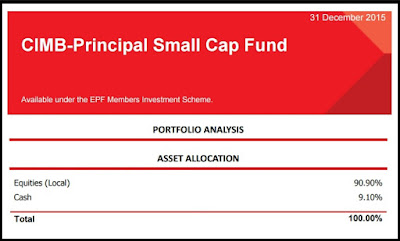Before we move into unit trust funds, let us take a look at the performance of our local index, otherwise known as Kuala Lumpur Stock Exchange in terms of YTD as of 31st January 2016.
 |
| KLSE YTD as of 29th January 2016 : -1.46% |
 |
| EMAS Index YTD as 0f 29th January 2016 : -2.97% |
What about the performance of Malaysia Equity Unit Trust Funds?
For the purpose of performance analysis, I've picked the two best performing Malaysia equity fund category from last year as listed in this post entitled Top 20 Best Performing Unit Trust Fund for 2015. The categories that I've chosen are:
- Equity - Malaysia Mid/Small-cap (Shariah)
- Equity - Malaysia Mid/Small-cap
Top 10 funds ranked according to the lowest (%) percentage loss over this period as shown below:
 |
| Top 10 Equity - Malaysia Mid/Small-cap (Shariah) ranked according to YTD |
Top 10 funds ranked according to the lowest (%) percentage loss over this period as shown below:
 |
| Top 10 Equity - Malaysia Mid/Small-cap ranked according to YTD |
- 8 out of 10 Shariah funds listed in the ranking table above performed better than the EMAS index.
- Only two (2) out of 10 funds in the table performed better than the KLSE index.
- The riskier nature of "medium and small cap stocks" invested by funds from this category should warrant a higher percentage of losses in comparison to that benchmark index (especially during a volatile market). This point is proven just by looking at the other end of the ranking table for both these categories.
 |
| 3 Worst Performing Fund for Category Equity Malaysia Mid/Small-cap (Shariah) as of YTD 31 Jan 2016 |
 |
| 3 Worst Performing Fund for Category Equity Malaysia Mid/Small-cap as of YTD 31 Jan 2016 |
Why some funds in the Top 10 are able to post results which are close or better than the indexes?
In order to determine a possible answer to the question above, I took an unorthodox approach by checking the percentage of cash/liquidity held by these funds before 2016. The reason for doing so is as explained below:
- My believe is that fund managers for these funds have made a calculated prediction that 2016 might be a bearish year for equities.
- When a bearish market is predicted, fund managers tend to take a defensive position by holding more cash in the fund's portfolio.
- And in most cases, the percentage of cash held is 20% or higher depending on how bearish the prediction is.
Outcome of percentage (%) cash held by the these fund before 2016
I've summarized the percentage (%) of cash held by the Top 10 funds for both categories below. Let's take a look:
1) Percentage (%) Cash Allocation for Top 10 Equity - Malaysia Mid/Small-cap (Shariah) funds
 |
| N/A : No data available |
2) Percentage (%) Cash Allocation for Top 10 Equity - Malaysia Mid/Small-cap funds
 |
| N/A : No data available |
Analysis
- Out of the total 20 funds from both categories, 6 funds have more than 20% cash allocation in their portfolio.
- 7 funds have between 14% to 20% cash holdings.
- Funds with N/A status cannot be verified as I was unable to obtain the portfolio data of these funds as of 31st Dec 2015
- To further proof my point above, let me show you how little is the cash holdings for two funds from the Top 3 Worst Performing list:
Cash/Liquidity : 4.23%
Sample 2 : CIMB-Prinicpa Small Cap Fund
Cash/Liquidity : 9.10%
What's the point of looking at all these data?
Here's my explanation:
- You now have in your hands the data of funds with high cash allocation in their portfolio.
- As of posting date (20th Feb 2016), I am pretty sure these funds are still holding a high percentage of cash. You can check the fund factsheet for January 2016 to double confirm.
- In laymen terms, funds with 20% or more cash allocation have more "bullets" or "ammo" as compared to rival funds.
- In the event that the bearish prediction for 2016 comes true, these "cash rich" funds have the luxury of purchasing stocks at low prices.
- And when stocks (purchased at low prices) recover from a bear market, these funds would have the best chance to post outstanding returns if you've invested into them at the early stages!
Summary
The "portfolio cash allocation" method is an unorthodox unit trust selection method created by Invest Made Easy. This method rides on the assumption that when a fund manager is increasing the cash allocation of the fund that they manage, it could signify the following possibility:
- A bear market is approaching
- There's a buying opportunity for certain stocks.
- Raising cash for payment of dividend to investors
As you can see, this method alone cannot be used to select a unit trust fund. Instead, use this method to compliment other available methods when you're selecting a unit trust fund.
That's all from me!
If you like this post, do:
- Give us a LIKE on our Facebook page
- Give us a "+1" for Google+ located below.
- Share this post on Facebook (just click on the share button below)
P.S : If you have further questions or would like to request for a personal coaching on unit trust investment, feel free to drop me an email at shanesee03@gmail.com



Ur research is remarkable and your presentation points are easy to grasp Great Job!Tq!
ReplyDeleteThanks Syaiful. Much appreciated. :)
Delete